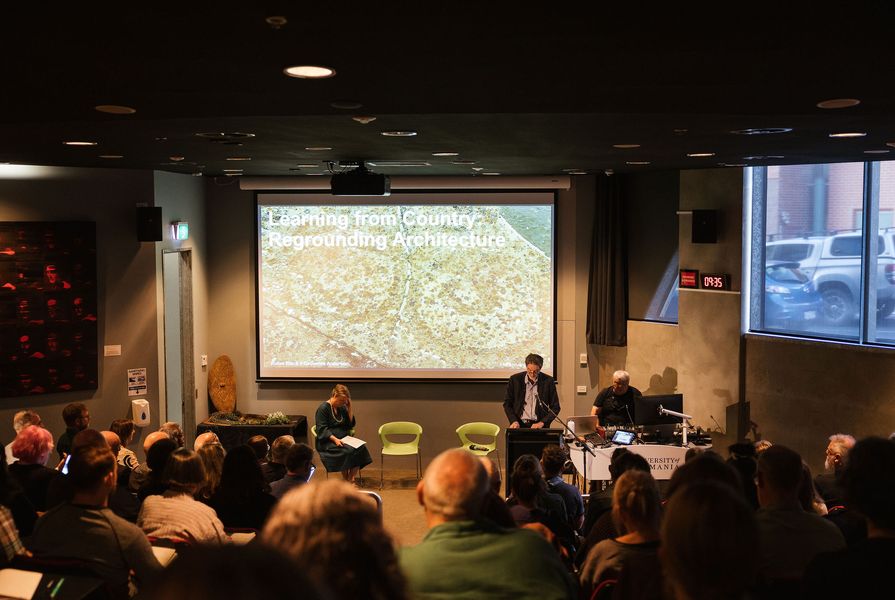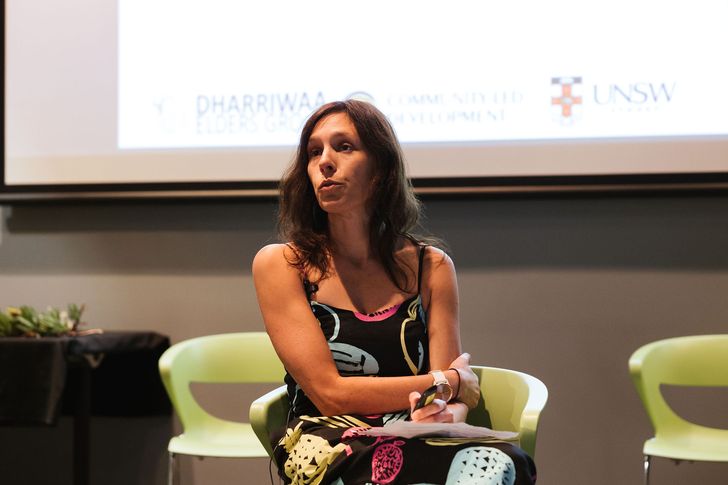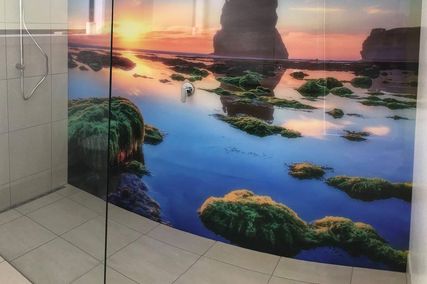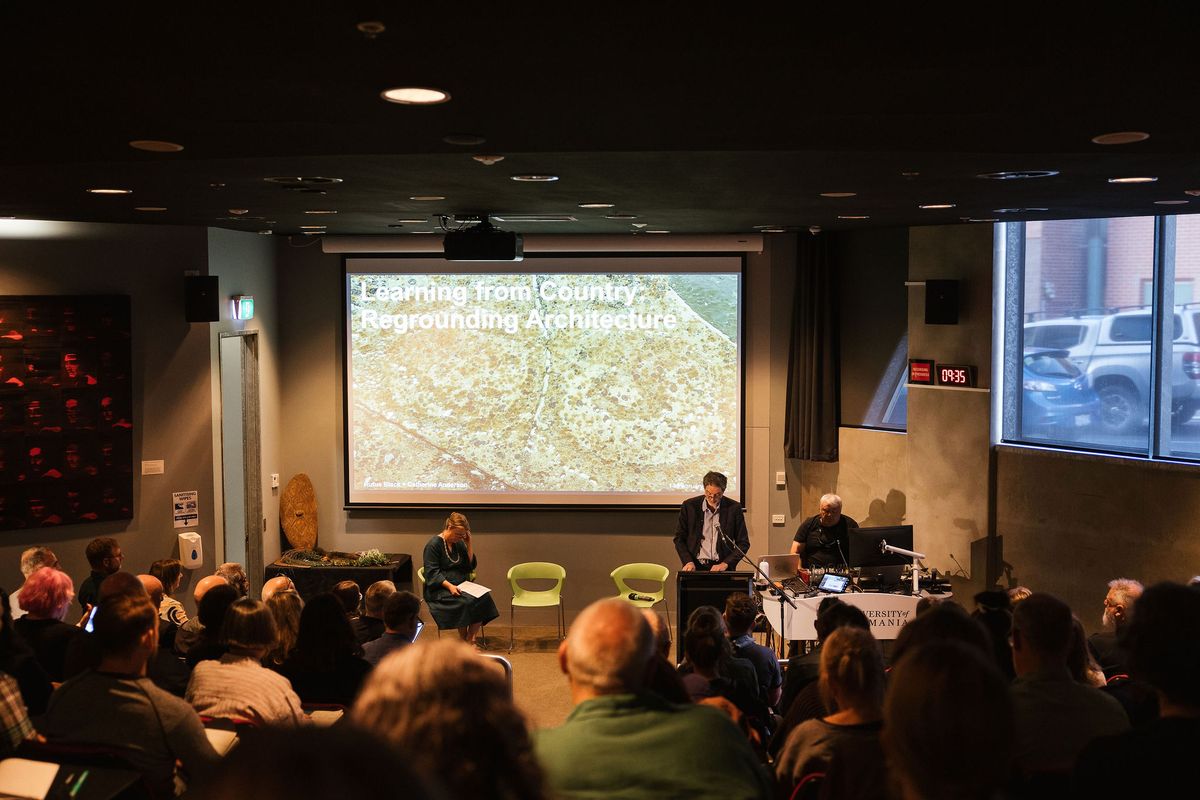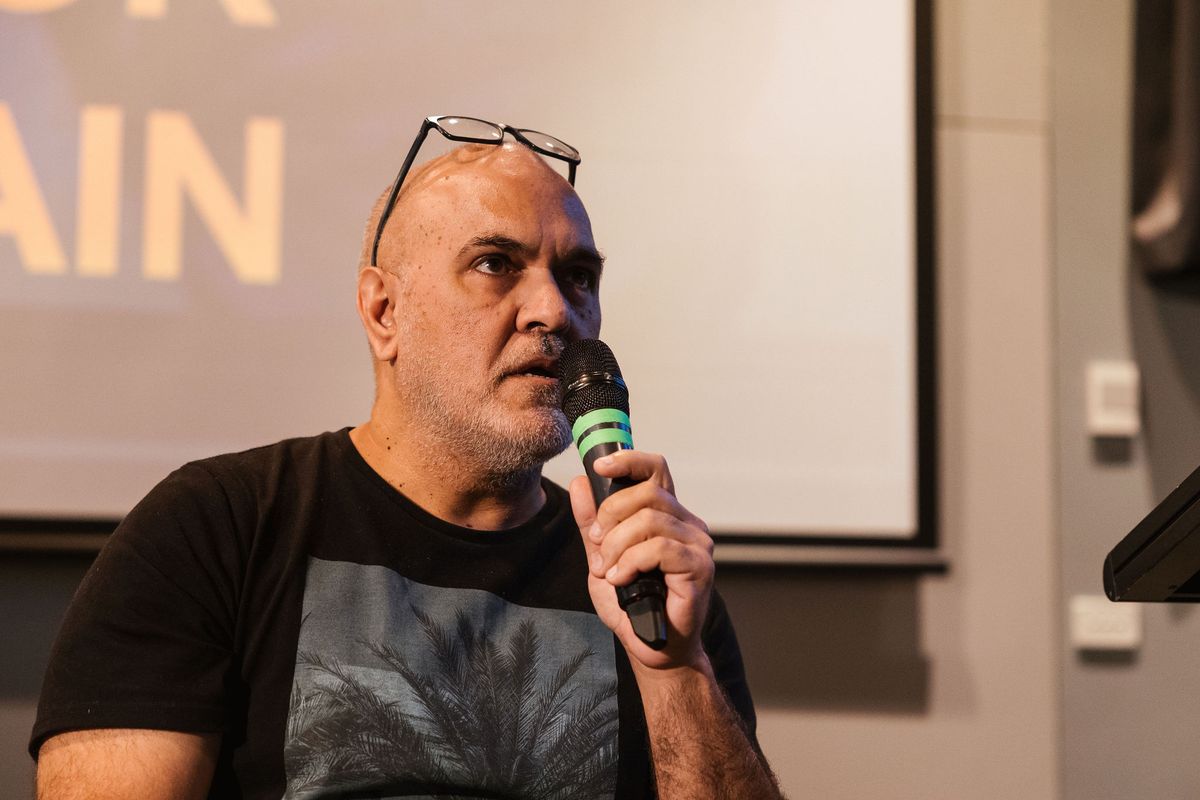Centurion, a Eucalyptus regnans, stands as the world’s tallest flowering tree, an ancestor of the ancient and living nipaluna landscape. With roots half a millennia in age, one can only imagine the stories woven in their presence. Prior to colonisation, this Country was cared for, healthy and thriving with life in a land unharmed. Visiting Centurion on the day preceding the Australian Institute of Architects’ Country Culture Community conference, I marvelled at the sublime landscapes and resilient microclimates, enveloped in the scent of eucalyptus oils infused with the musk of the rainforest. However, the impact of colonisation is evident: land is scarred by material extraction, dust clouds trail logging trucks laden with eucalyptus ancestors. It was eerie.
Welcoming visitors to nipaluna Country for the conference was Trish Hodge, a proud Palawa woman from the Trawlwoolway people. Supporting Trish was her daughter, full of energy and spirit, dancing for the first time to strangers. She was learning, practising and sharing culture as the next generation to take the baton. Our spirits were cleansed by the smoke of peppermint gum leaves, the tone was set, the conversations could begin.
A Welcome to Country ceremony with Trish Hodge.
Image: Nina Hamilton
The Country Culture Community conference was an inaugural event of its type for the Australian Institute of Architects, but centuries overdue. It was also topical, given the recent inclusion of the Country, First Nations Cultures and Communities in the 2021 National Standard of Competencies for Architects, and the Voice referendum result driving the need for activism and social change to flip the script to decolonise practice and process. Trail-blazing practitioners and community leaders shared their experience working within the intersection of Country, culture, community and the built environment, exploring thought-provoking discussions on material extraction and consumption, relational ontology, cultural protocol, reciprocity, cultural load, restitution and repatriation, and social, political and economic opportunities, to name a few.
Uncle Peter (Bumi) Hyde and Shaneen Fantin at the Country Culture Community conference
Image: Nina Hamilton
Uncle Peter (Bumi) Hyde and Shaneen Fantin shared the value of respect, friendship, transparency, generosity and reciprocity – and also fun and love – in their relationship, established through self-positioning to enable honest and empathetic connectedness. They noted the virtue of patience and the importance of “knowing yourself, where you come from, who you are, what your background is, what your ancestors did”.
When Samantha Rich and Michael Mossman introduced interactive stories and micro-conversations between participants about personal protocols and setting expectations, and reflections on the themes of aura, Country, terror and refrain, the room erupted. We explored the relational ontology of family, story, colonialism and architecture through the lens of the themes. “Tell us your story,” Michael urged.
Samantha Rich speaking at the Country Culture Community conference
Image: Nina Hamilton
These perspectives illustrate notions of positioning and rapport as a vessel to deeply reckon and connect with one’s own history and culture, to construct genuine lasting relationships leading to a valued understanding with others to drive opportunity for empathy, two-way learning and innovation.
Troy Casey asked: “Is the zeitgeist of designing with Country another form of colonisation? Who’s benefiting from all of this?” Although hope for the future was an enduring undertone of the conference, the mandatory nature of designing with Country has had some detrimental effects within the industry and First Nations communities. These include tokenism, disingenuous transactional engagements and the additional cultural load on First Nations practitioners and communities. “There is a cultural dimension that I don’t think … aligns with our professional responsibilities [as architects]. I’m a big believer that [Country] is something you should engage with as a matter of choice, not as a requirement,” said Kevin O’Brien.
Kevin O’Brien speaking at the Country Culture Community conference.
Image: Nina Hamilton
This statement led us to consider our roles in this revised process of architecture, and to ask who the right person for the job is. The notion of agency suggests that projects of specific cultures should be led by agents of that culture. “You wouldn’t get someone who is not Jewish, or not an architect, to design a Jewish museum in Berlin,” noted O’Brien. This was followed by a healthy debate about the roles of non-Indigenous practitioners in this intersection. As architects, we have an obligation to make sure that communities know there are First Nations architects in practice, so that they have the choice to work with, or reject, their services – that is the point of agency. Further, we have a responsibility to ensure that projects that involve designing and connecting with Country have scope for First Nations community opportunity, participation, use, obligations, remuneration and time; and that the process involves genuine engagement, collaboration, inclusion, reciprocity and mutual benefit.
The importance of time, humility and process over outcome was well documented throughout the conference. According to Bianca Scaife: “Time is critical for so many things. It takes time to build trust. First Nations communities can understandably be hesitant or cynical about engagement with designers they’ve never met before, especially if they’ve had experiences where engagement was done in a token manner, focused on ticking a box, or treated as a one-way extractive process.”
The creative directors of Australia’s 2023 Venice Biennale exhibition shared that “[The process] highlights the importance of humility and vulnerability, allowing the process to take precedence over the outcome … we made ourselves humble to the process, to each other, vulnerable … to decolonise our own internal processes.”
Sarah Rhodes, one of the creative directors of Australia’s 2023 Venice Biennale exhibition.
Image: Nina Hamilton
There was consensus on issues of reform regarding forced responsibilities, cultural load and culturally inappropriate processes, such as bureaucrats controlling the narrative in a space where they are not willing to compromise. A conference delegate noted, “I cannot stand white bureaucrats … they get in the way and stop us from communicating with people we need to have meaningful engagement with.” Unless social change occurs, we will continue to work in what is systematically, experientially and architecturally a colonial paradigm. A representative of Aboriginal Housing Victoria noted that social housing programs benefit from streamlined planning processes and permit exemptions, but Indigenous social housing does receive the same allowances.
Decarbonisation was another hot topic, considering the ramifications of specification, and the relationship between extraction and commodification of land, Country, resources, cultures and knowledges. Again we asked: who are the beneficiaries of designing and connecting with Country? Michael McMahon shared his perspective on designers’ responsibilities when deciding on materials: “Are we doing harm? Through our decisions, are we caring for place?” This expanded into questioning the contrary nature of extraction from distant locations, relative to sustainability, and the intrinsic relationship that materials have with place, story and community. Some of these materials are upwards of 400 million years old. What has this material seen? What is its relationship to this place?
Beginning the year with Country in the forefront of people’s minds, and enabling a space for the Voice of trailblazers to upskill the capacity, capability and advocacy within our communities, is a step forward. Who will be next to pick up the baton, and how do we position them to create a better future for several generations ahead?
The Australian Institute of Architects’ Country Culture Communit conference was held in nipaluna/Hobart at the University of Tasmania from 14 to 16 February.

